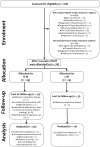Prevalence of Non-responders for Glucose Control Markers after 10 Weeks of High-Intensity Interval Training in Adult Women with Higher and Lower Insulin Resistance
- PMID: 28729841
- PMCID: PMC5498508
- DOI: 10.3389/fphys.2017.00479
Prevalence of Non-responders for Glucose Control Markers after 10 Weeks of High-Intensity Interval Training in Adult Women with Higher and Lower Insulin Resistance
Abstract
Background: Exercise training improves performance and biochemical parameters on average, but wide interindividual variability exists, with individuals classified as responders (R) or non-responders (NRs), especially between populations with higher or lower levels of insulin resistance. This study assessed the effects of high-intensity interval training (HIIT) and the prevalence of NRs in adult women with higher and lower levels of insulin resistance. Methods: Forty adult women were assigned to a HIIT program, and after training were analyzed in two groups; a group with higher insulin resistance (H-IR, 40 ± 6 years; BMI: 29.5 ± 3.7 kg/m2; n = 20) and a group with lower insulin resistance (L-IR, 35 ± 9 years; 27.8 ± 2.8 kg/m2; n = 20). Anthropometric, cardiovascular, metabolic, and performance variables were measured at baseline and after 10 weeks of training. Results: There were significant training-induced changes [delta percent (Δ%)] in fasting glucose, fasting insulin, and homeostasis model assessment of insulin resistance (HOMA-IR) scores in the H-IR group (-8.8, -26.5, -32.1%, p < 0.0001), whereas no significant changes were observed in the L-IR. Both groups showed significant pre-post changes in other anthropometric variables [waist circumference (-5.2, p < 0.010, and -3.8%, p = 0.046) and tricipital (-13.3, p < 0.010, and -13.6%, p < 0.0001), supra-iliac (-19.4, p < 0.0001, and -13.6%, p < 0.0001), and abdominal (-18.2, p < 0.0001, and -15.6%, p < 0.010) skinfold measurements]. Systolic blood pressure decreased significantly only in the L-IR group (-3.2%, p < 0.010). Both groups showed significant increases in 1RMLE (+12.9, p < 0.010, and +14.7%, p = 0.045). There were significant differences in the prevalence of NRs between the H-IR and L-IR groups for fasting glucose (25 vs. 95%, p < 0.0001) and fasting insulin (p = 0.025) but not for HOMA-IR (25 vs. 45%, p = 0.185). Conclusion: Independent of the "magnitude" of the cardiometabolic disease (i.e., higher vs. lower insulin resistance), no differences were observed in the NRs prevalence with regard to improved HOMA-IR or to anthropometric, cardiovascular, and muscle performance co-variables after 10 weeks of HIIT in sedentary adult women. This research demonstrates the protective effect of HIIT against cardiometabolic disease progression in a sedentary population.
Keywords: high-intensity interval training; insulin resistance; non-responders; women.
Figures
References
-
- Álvarez C., Ramírez-Campillo R., Ramírez-Vélez R., Izquierdo M. (2017). Effects and prevalence of nonresponders after 12 weeks of high-intensity interval or resistance training in women with insulin resistance: a randomized trial. J. Appl. Physiol. 122, 985–996. 10.1152/japplphysiol.01037.2016 - DOI - PubMed
LinkOut - more resources
Full Text Sources
Other Literature Sources



